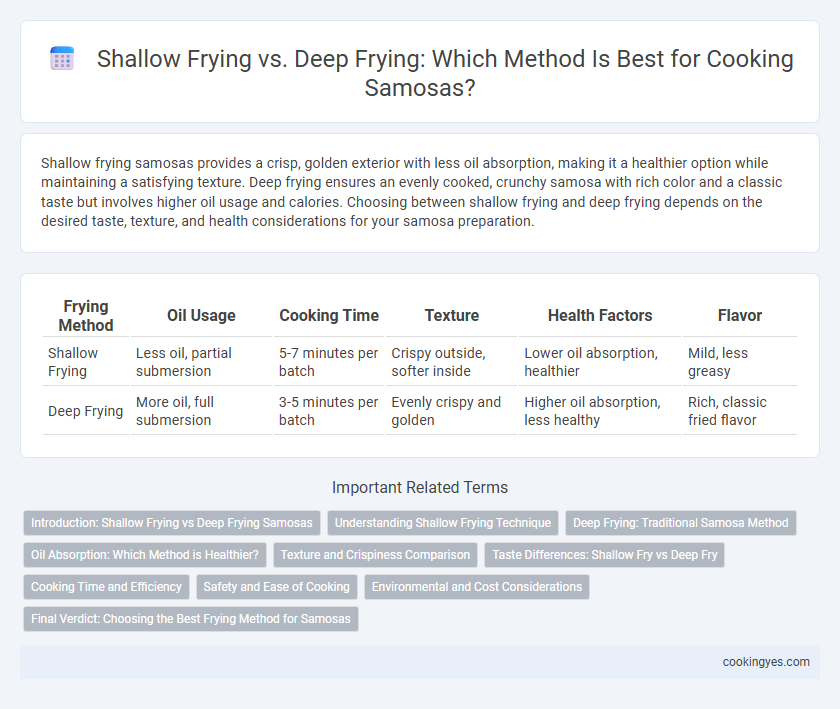Shallow frying samosas provides a crisp, golden exterior with less oil absorption, making it a healthier option while maintaining a satisfying texture. Deep frying ensures an evenly cooked, crunchy samosa with rich color and a classic taste but involves higher oil usage and calories. Choosing between shallow frying and deep frying depends on the desired taste, texture, and health considerations for your samosa preparation.
Table of Comparison
| Frying Method | Oil Usage | Cooking Time | Texture | Health Factors | Flavor |
|---|---|---|---|---|---|
| Shallow Frying | Less oil, partial submersion | 5-7 minutes per batch | Crispy outside, softer inside | Lower oil absorption, healthier | Mild, less greasy |
| Deep Frying | More oil, full submersion | 3-5 minutes per batch | Evenly crispy and golden | Higher oil absorption, less healthy | Rich, classic fried flavor |
Introduction: Shallow Frying vs Deep Frying Samosas
Shallow frying samosas involves cooking them in a small amount of oil, which results in a less oily texture and crisper exterior, preserving the delicate flavors of the filling. Deep frying submerges samosas in hot oil, creating an evenly golden, crunchy crust and enhancing the overall taste through thorough cooking. Choosing between shallow frying and deep frying impacts oil absorption, texture, and the final sensory experience of traditional samosas.
Understanding Shallow Frying Technique
Shallow frying samosas involves cooking them in a limited amount of oil, typically covering half to two-thirds of the samosa, allowing better control over the temperature and reducing overall oil absorption. This technique helps achieve a crispy, golden exterior while maintaining a slightly lighter texture compared to deep frying, which fully submerges samosas in hot oil. Maintaining consistent medium heat during shallow frying prevents excessive oil penetration and ensures even cooking, making it a healthier alternative with a balanced crunch and taste.
Deep Frying: Traditional Samosa Method
Deep frying is the traditional method for cooking samosas, ensuring a crispy, golden-brown exterior and evenly cooked, flavorful filling. Immersed completely in hot oil at around 350degF (175degC), samosas develop a crunchy texture while retaining moisture inside. This method enhances the authentic taste and characteristic crunch that defines classic samosas.
Oil Absorption: Which Method is Healthier?
Shallow frying samosas uses less oil, resulting in lower oil absorption compared to deep frying, which fully submerges the samosas in hot oil. Studies show that shallow frying can reduce calorie intake by up to 30%, making it a healthier choice for minimizing fat consumption. However, proper temperature control is crucial in both methods to prevent excessive oil uptake and ensure a crispy texture.
Texture and Crispiness Comparison
Shallow frying samosas results in a moderately crispy outer layer with a slightly softer texture due to less oil absorption, preserving the balance between crunch and tenderness. Deep frying produces a uniformly golden, intensely crispy crust with a firmer bite, as the samosas are fully submerged, allowing even cooking and oil penetration. For maximum crunchiness and a consistent crisp texture, deep frying is preferred, while shallow frying offers a lighter alternative with reduced oil content.
Taste Differences: Shallow Fry vs Deep Fry
Shallow frying samosas results in a lighter, crisp exterior with a subtle oiliness that allows the filling's spices to shine through, creating a balanced taste experience. Deep frying produces a richer, crunchier crust with a more pronounced fried flavor and slightly greasier texture, enhancing the samosa's overall indulgence. Taste preferences often depend on whether one favors a delicate crispness or a hearty, robust fried taste.
Cooking Time and Efficiency
Shallow frying samosas typically requires 6-8 minutes per batch, offering faster cooking times and lower oil consumption compared to deep frying. Deep frying samosas, while ensuring a crispier texture, takes about 10-12 minutes and uses a larger quantity of oil, impacting both cooking efficiency and cleanup. Shallow frying is more energy-efficient and suitable for small batches, whereas deep frying is ideal for larger quantities but involves higher oil usage and longer frying duration.
Safety and Ease of Cooking
Shallow frying samosas requires less oil, reducing the risk of oil splatters and burns, making it a safer option for home cooks. Deep frying, while creating a crispier texture, involves handling larger quantities of hot oil, which increases the risk of accidents and demands careful temperature control. Shallow frying is also easier to manage on standard stovetops, requiring less monitoring and less cleanup compared to deep frying.
Environmental and Cost Considerations
Shallow frying samosas uses less oil, significantly reducing environmental impact by minimizing oil consumption and waste disposal concerns compared to deep frying. Cost savings are evident as shallow frying requires lower quantities of oil, decreasing expenses on cooking oil and related waste management. Energy consumption is also lower in shallow frying since it uses less oil to heat, making it a more sustainable and economical cooking method for samosa preparation.
Final Verdict: Choosing the Best Frying Method for Samosas
Shallow frying samosas results in a crisp texture with less oil absorption, preserving the filling's flavors while making the cooking process quicker and healthier. Deep frying ensures an even golden-brown crust and a more traditional taste but involves higher oil usage and longer cooking time. For the best balance of taste, texture, and health, shallow frying is often recommended for home cooks seeking a lighter yet delicious samosa.
Shallow frying vs Deep frying for samosa cooking Infographic

 cookingyes.com
cookingyes.com